Delcy Morelos and Ettore Spalletti
Installation view: Delcy Morelos, Ettore Spalletti, “Esa Esquina Soy Yo”, Marian Goodman Gallery, New York, 2023 Courtesy of Delcy Morelos and Marian Goodman Gallery Photo credit: Alex Yudzon
Marian Goodman Gallery in New York is pleased to announce the upcoming exhibition by Delcy Morelos and Ettore Spalletti, which opened Wednesday, March 13, and will be on view through 20 April 2024. The exhibition's opening reception was held on Wednesday, 13 March, from 6 to 8 p.m.
Esa esquina soy yo will present works that span three decades and offer a dialogue between these two artists. The exhibition highlights distinct practices and processes, traversing past and present, bringing to light dual influences and trajectories, from Andean cosmology to explorations of color, geometries and relationship with space. In this exhibition we see their dynamic activation and a sublime transcendence.
In his work, where painting and sculpture merge together, Ettore Spalletti (1940-2019) offers a dialogue between classicism and contemporaneity. In his search for an essential dimension and a new idea of spatiality, there is a constant dialogue with the art of the past and, in particular, with the masters of Italian Renaissance art, from Piero della Francesca to Raffaello. His language eliminates all forms of rhetoric, recovering geometries and archetypal forms according to concepts that clearly distinguish him from Minimal Art.
Installation view: Delcy Morelos, Ettore Spalletti, “Esa Esquina Soy Yo”, Marian Goodman Gallery, New York, 2023 Courtesy of Fondazione Ettore Spalletti; Delcy Morelos and Marian Goodman Gallery Photo credit: Alex Yudzon
Fundamental to his poetics are the transformation of materials (alabaster, onyx, marble) and, above all, the definition of a particular painting technique. The painted surfaces, obtained through multiple layers of color impasto repeated over several days at the same time, following the final abrasion, are characterized by the presence of a certain amount of white pigment that, as it breaks, becomes a source of light. The light that comes from within the work intertwines itself with the variations of natural light that add color to color. Far from being absolutely monochrome, Spalletti’s painted surfaces offer a texture which gives breath to the image.
Color in Spalletti’s works always reveals a depth, just as in the words of Paul Valéry -"Ce qu'il y a de plus profond dans l'homme, c'est la peau”- with which the artist titled his solo exhibition at Galerie Marian Goodman in Paris in 2018. Contrary to contemporary trends, Spalletti spent his life in his native places, loving to call his studio home.
Ettore Spalletti Senza titolo, (grigio chiaro), 2019 Color impasto on board, tapered frame on 4 sides, gold leaf Courtesy of Fondazione Ettore Spalletti and Marian Goodman Gallery Photo credit: Alex Yudzon
Delcy Morelos' indigenous traditions inform her memories of her homeland and its hierarchies of skin, race, land and violence. Invoking a bodily materiality in her layers of paint poured and slowly applied to textile or fabric supports, the artist lets the paint drip, pool and solidify, creating vast pictorial fields that move away from the picture plane and extend to ceramics, textiles and large-scale immersive installations. Her evocative treatment of color suggests both the body and the earth, revealing what is most sacred to the artist and drawing a connection between the body and violence. Morelos' chromatic exploration of the color red, for example, especially in her early works, implies blood and matrilineal force. Taking cues from Andean ancestral traditions, Morelos favors textiles and fabrics and natural materials such as plant and mineral fibers, earth, clay, and soil. Conceiving of a fictional and primordial cosmos, her experiential artworks are made for the human senses and create “an alchemy that awakens different emotions in each person.”
Ettore Spalletti Carte rosa, 1998 Color impasto on panel, painted front and back Courtesy of Fondazione Ettore Spalletti and Marian Goodman Gallery Photo credit: Alex Yudzon
Spalletti's pink diptych, Carte rosa, 1998, is the anchor of the North Gallery space, in dialogue with Morelos' series, Eva, from 2013. The work is made with an impasto of color painted on the front and back of two slender wooden paper panels that move in response to atmospheric shifts. The color pink is, as the artist tells it, the color of the human skin "which never has a fixity of its own but is continually transformed through the mood we experience." Next to these, Morelos' work, Eva, 2013, extends into three-dimensional space and volumetric form. A fabric structure, suspended in space, stands across from of a series of works, Eva. 1-10, 2013. Objectively geometric, they are made with clay, brick dust and binder on cotton weave, with earth tones that recall soil and color, life and the female body. As Morelos said, the earth contains in its womb the very cycles of life, death and rebirth, and is a feminine deity.
Delcy Morelos Eva, 2013 Clay, brick dust, and acrylic binder on cotton weave Courtesy of Delcy Morelos and Marian Goodman Gallery Photo credit: Alex Yudzon
In the North Gallery Viewing Room, a series of works by Morelos made with thick layers of acrylic on cotton thread, titled The Double Negation (La doble negación), 2008, bring the minimalist grid closer to the dense tactility of paint droplets, which serve to structure the surfaces of the lattice works. In the center of the room is Spalletti's Colonna, portacipria, 2016: a circular form of pink onyx, concealing within it a powder of the same color, rests on a white marble column, a form dear to Spalletti, which has spanned the entire history of art and architecture.
In the South Gallery is Senza titolo, azzurro, 1990, with its three-sided bull frame. Light blue for Spalletti, as the artist put it, is "an atmospheric color, in which we are continually immersed, it is the color of the sky [...] ours is a sky of meditation, when you take a walk by the sea towards evening the line of the horizon is no longer visible, the sea joins the sky. You feel that space never ends, there is no image, but if you try to pierce the blue with a finger, what do you find? You are in contemplative reality. I think of Beato Angelico." Mobile, 1994, a sculpture painted in a different shade of pink than the Carte rosa in the North Gallery space, offers an example of Spalletti's research into the relationship between sculpture and spatiality. The three-dimensional volume, placed in mid-air, seems to come out the wall and interacts with Senza titolo (grigio chiaro), 2019, whose profile is animated by a girandola frame on the four sides characterized by the use of gold leaf.
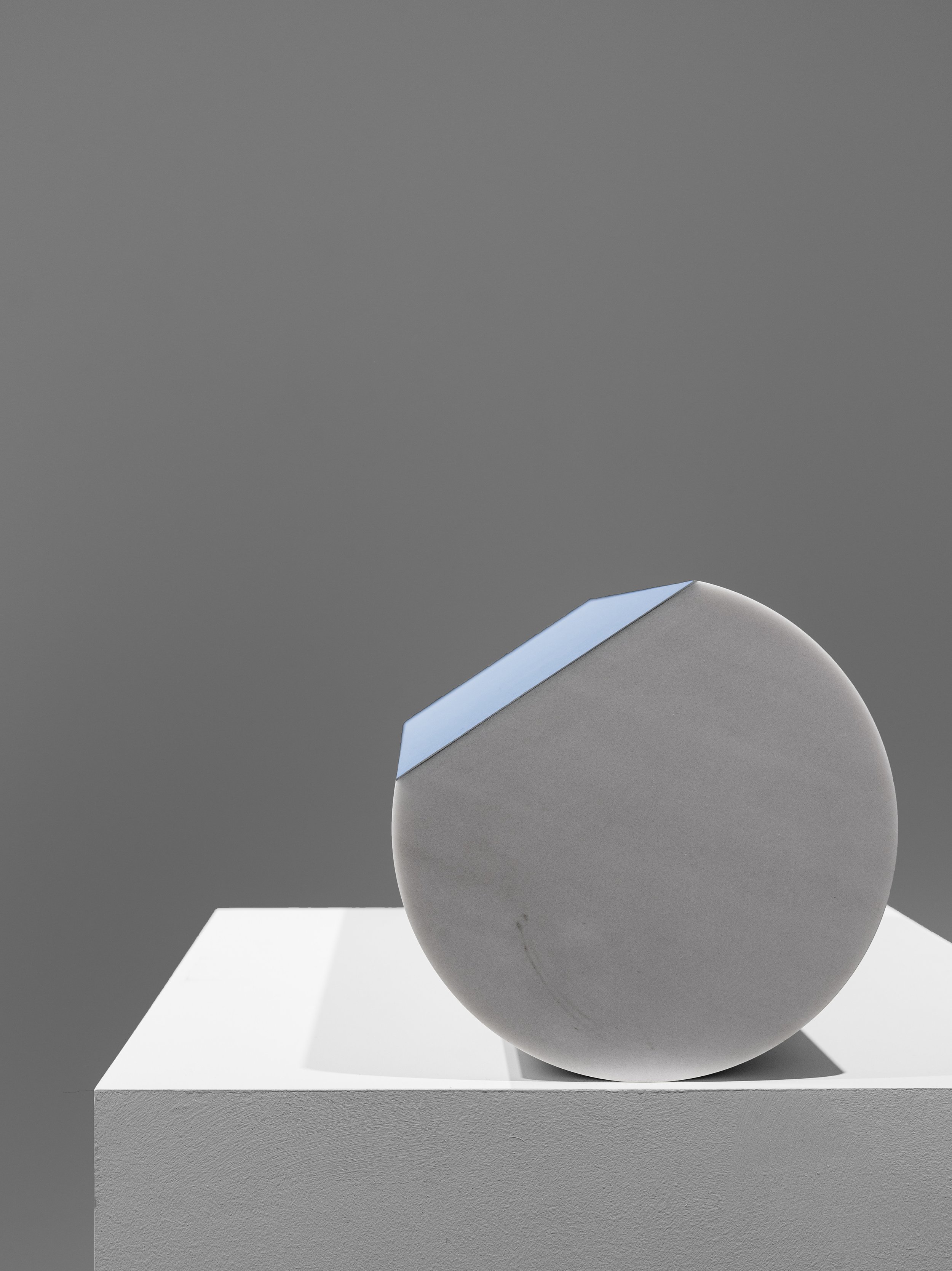
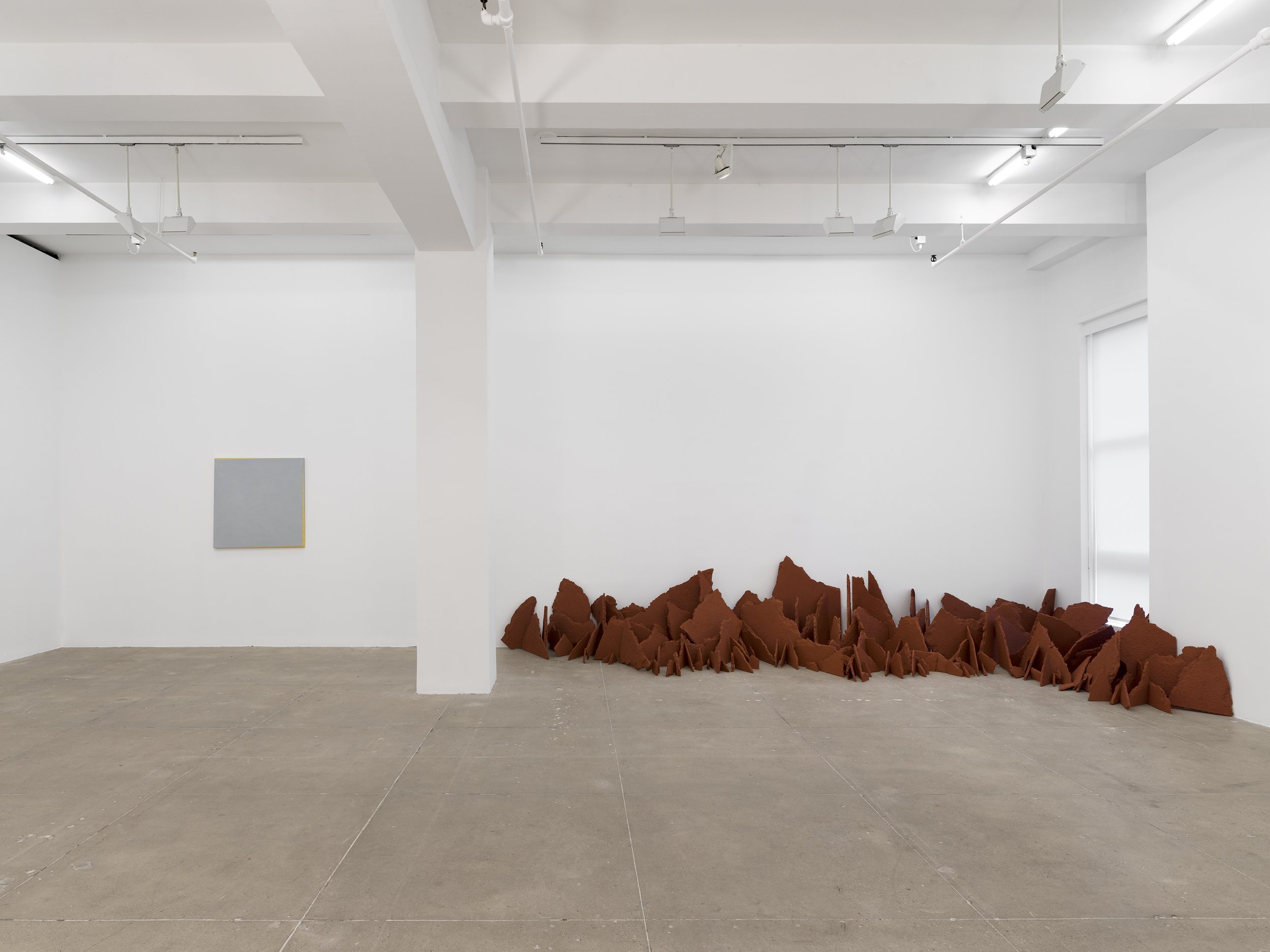

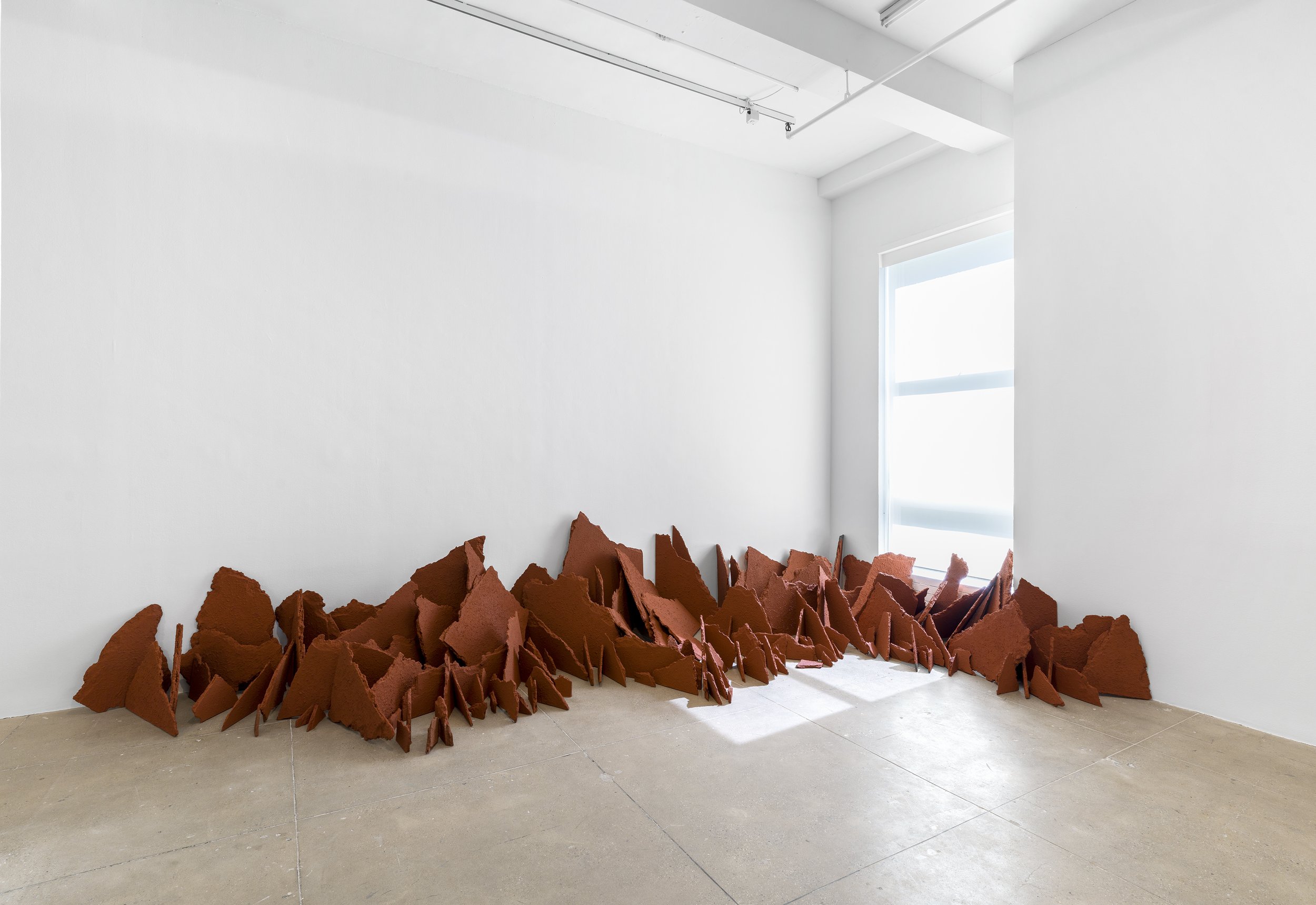
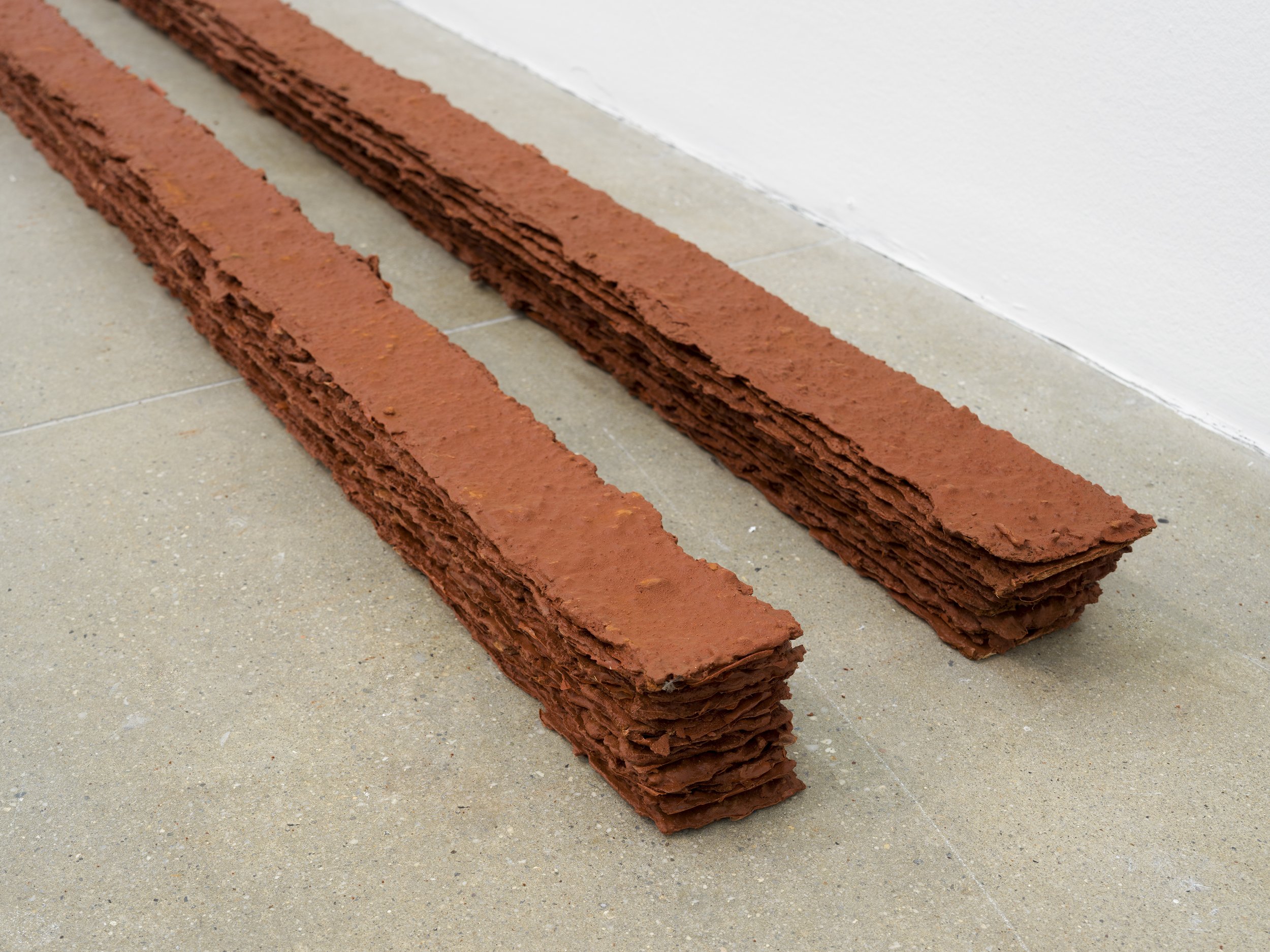
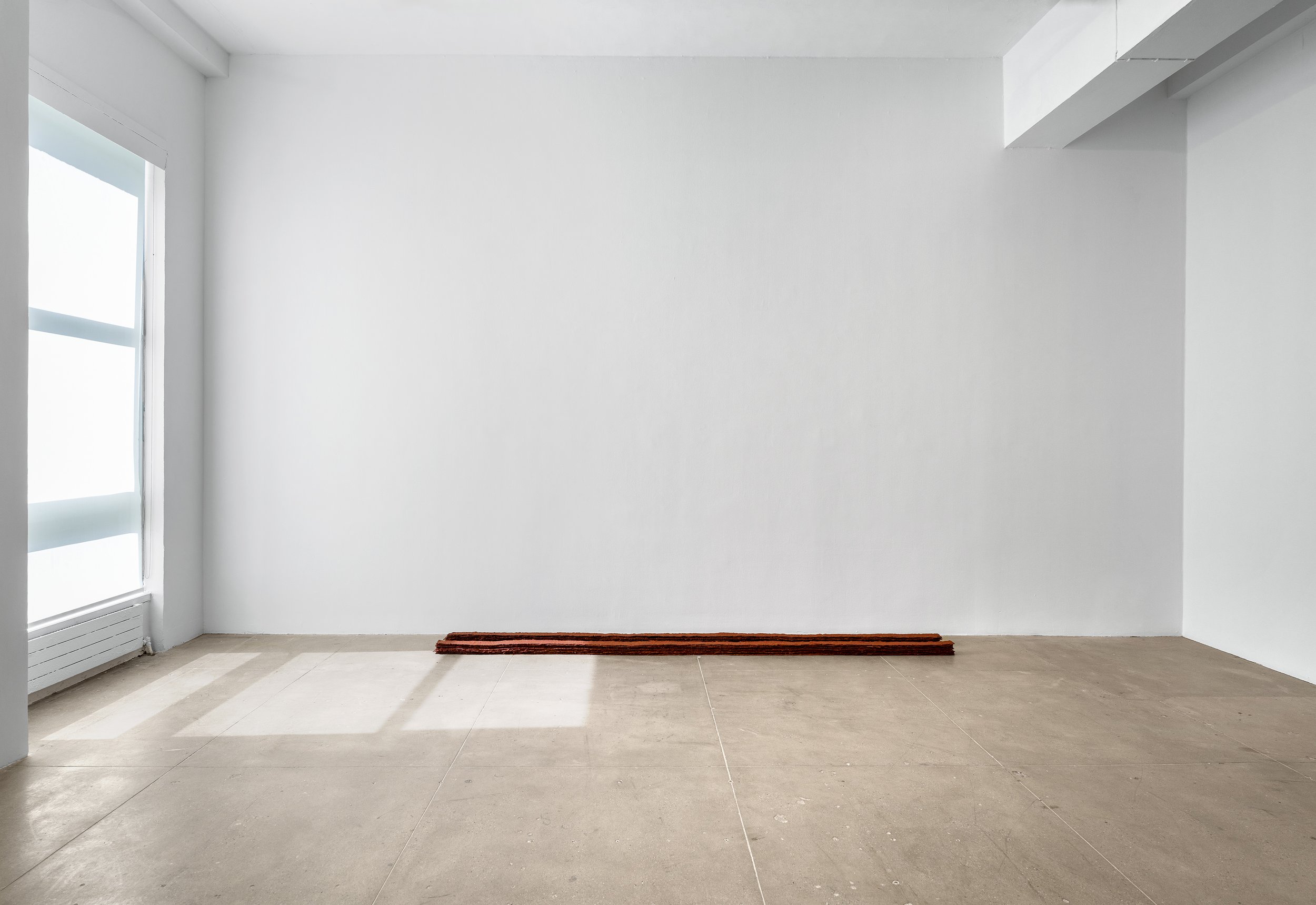
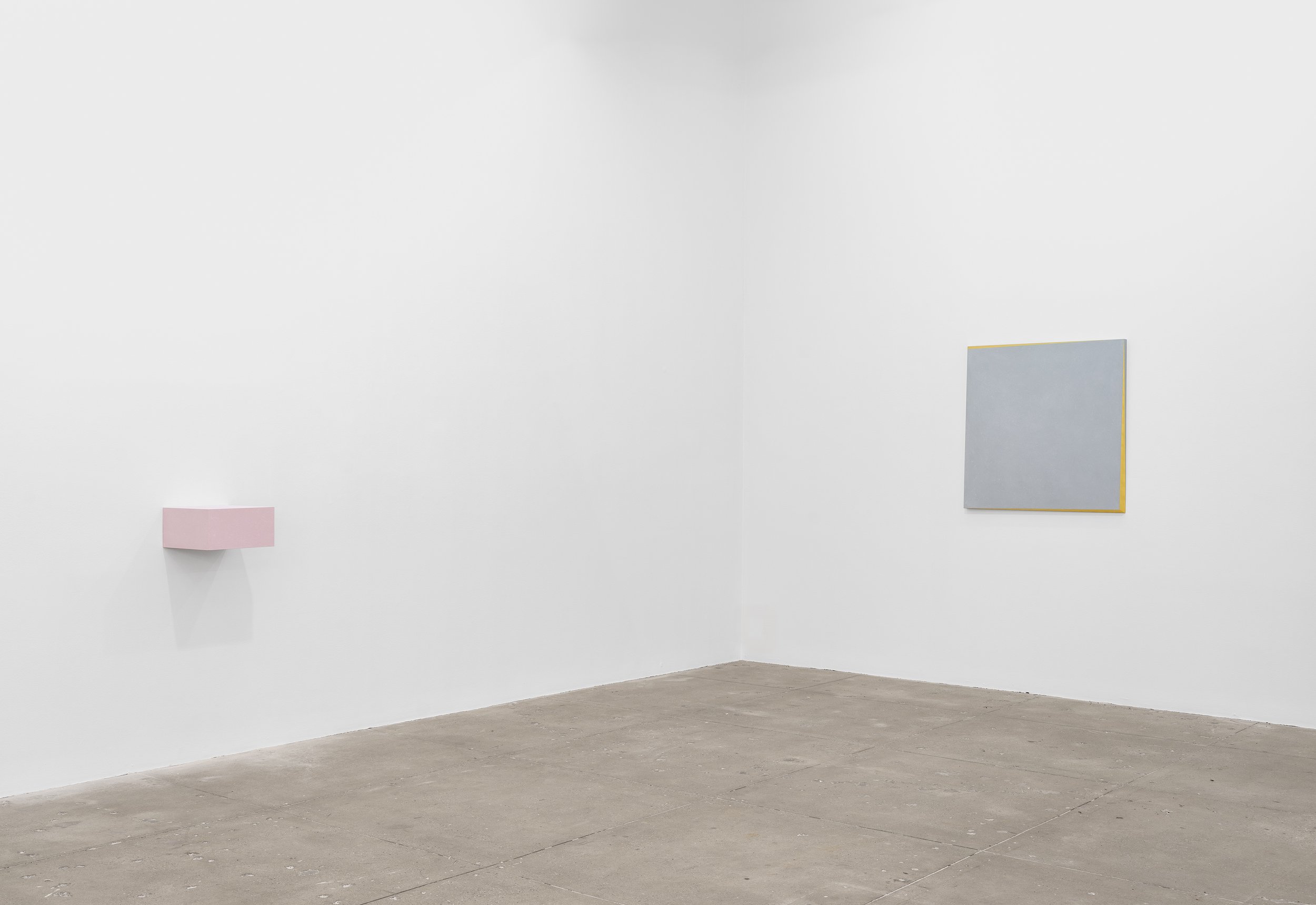
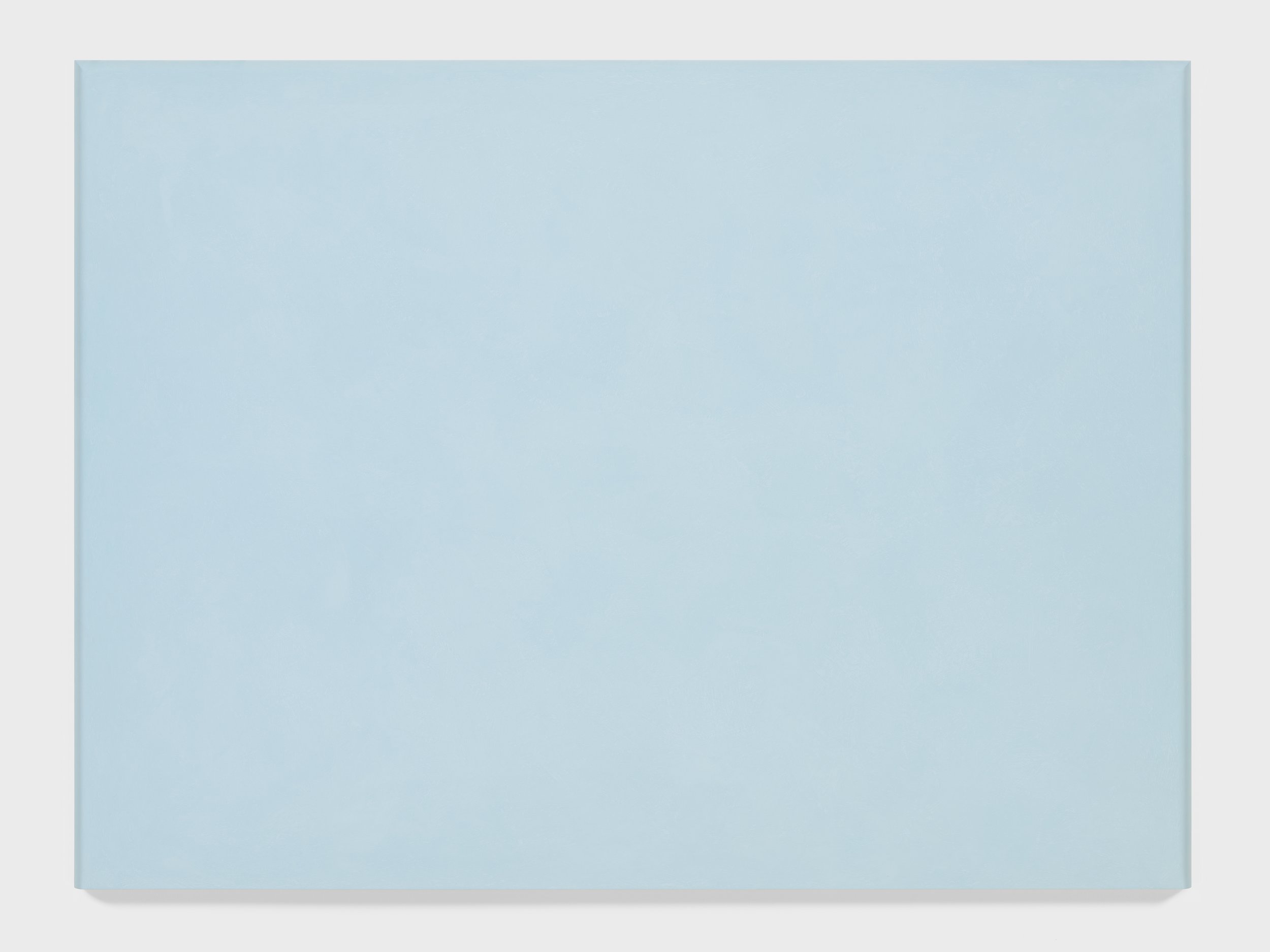
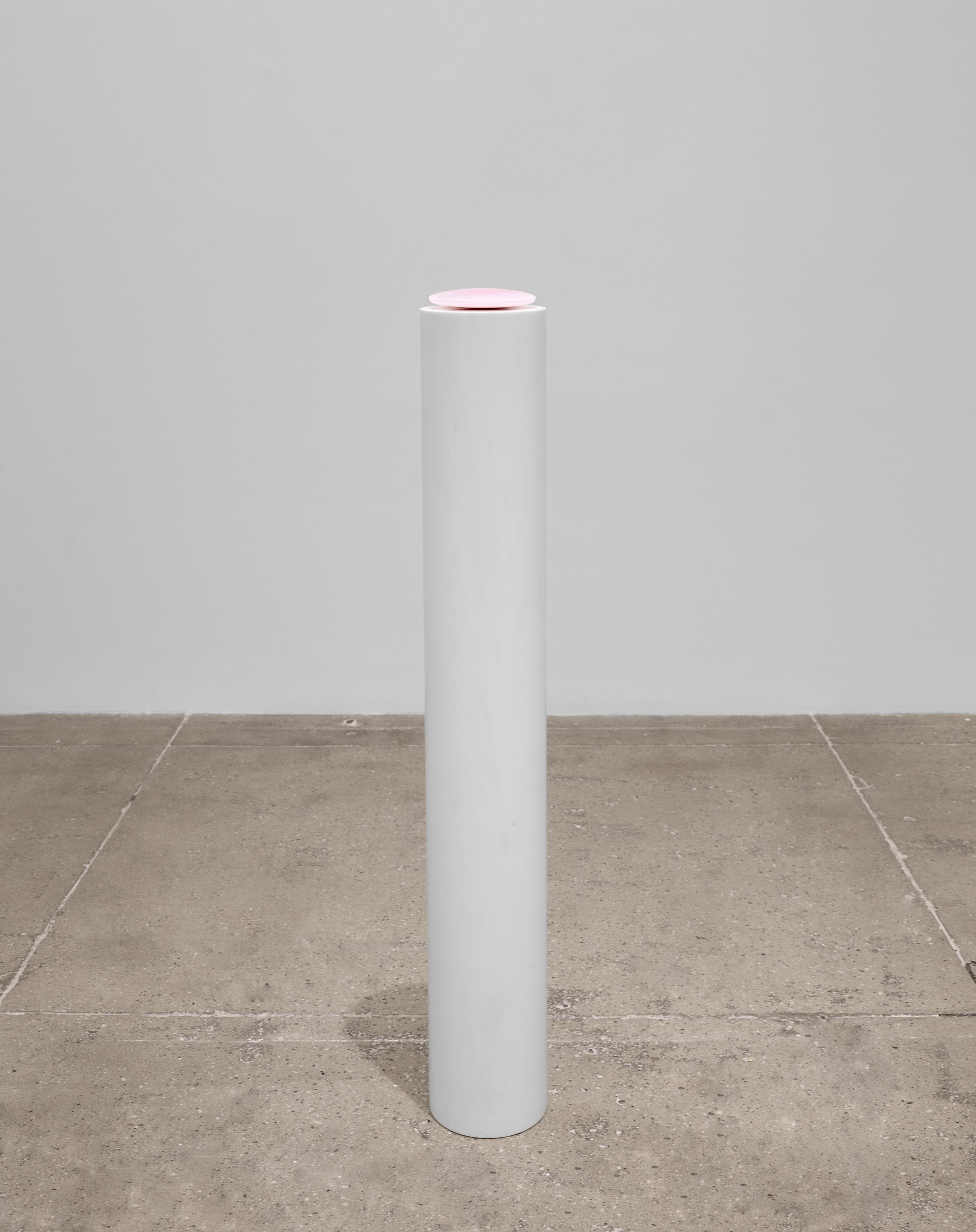
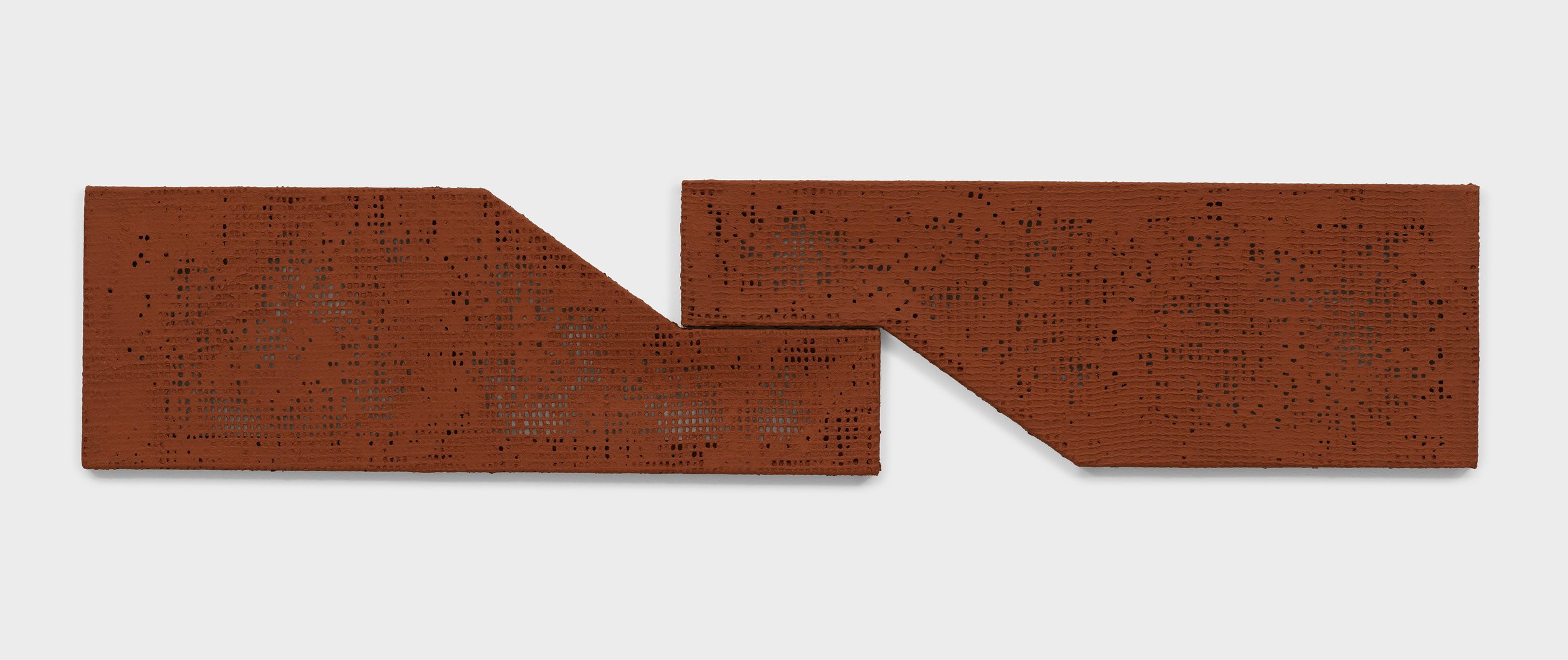
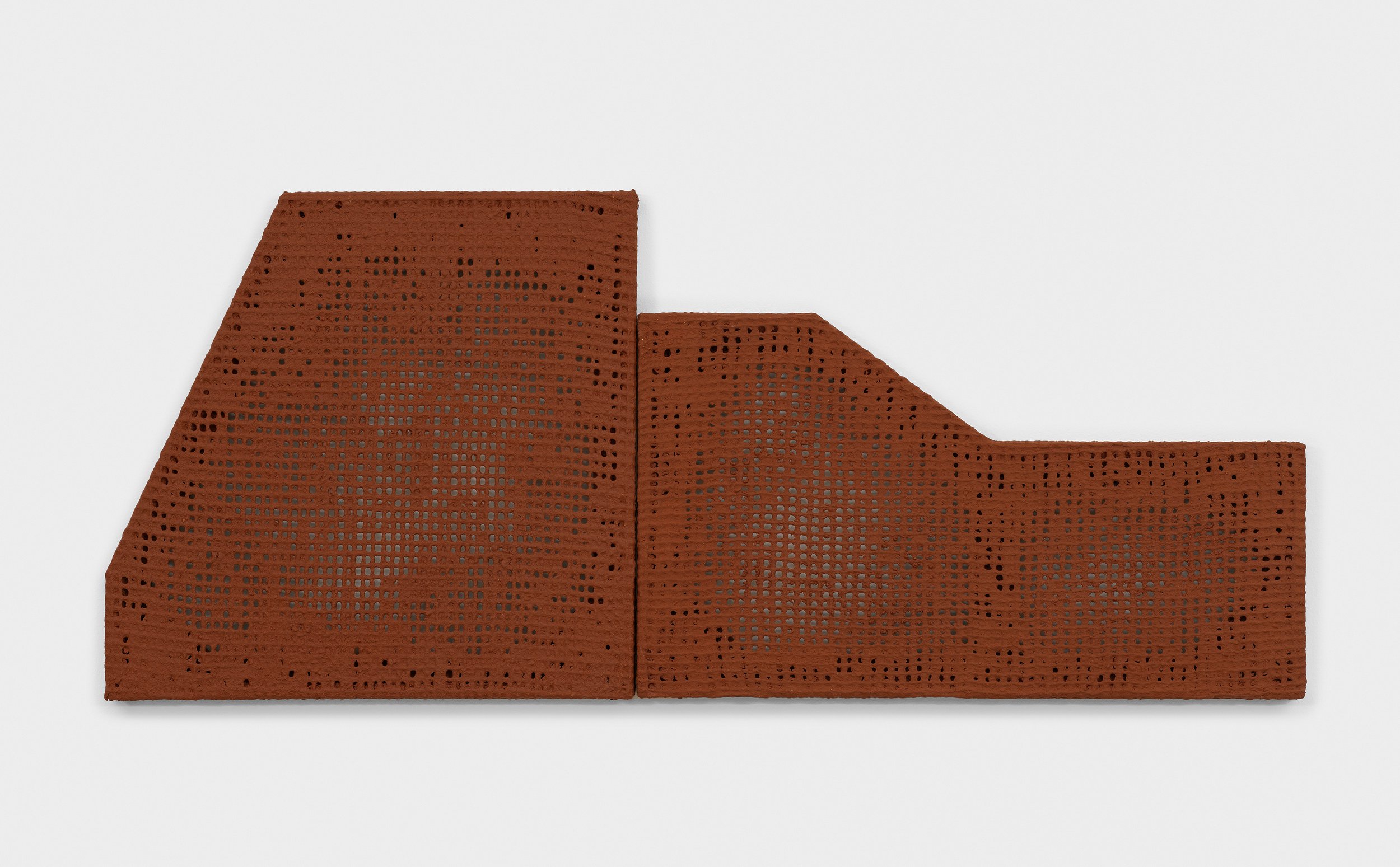
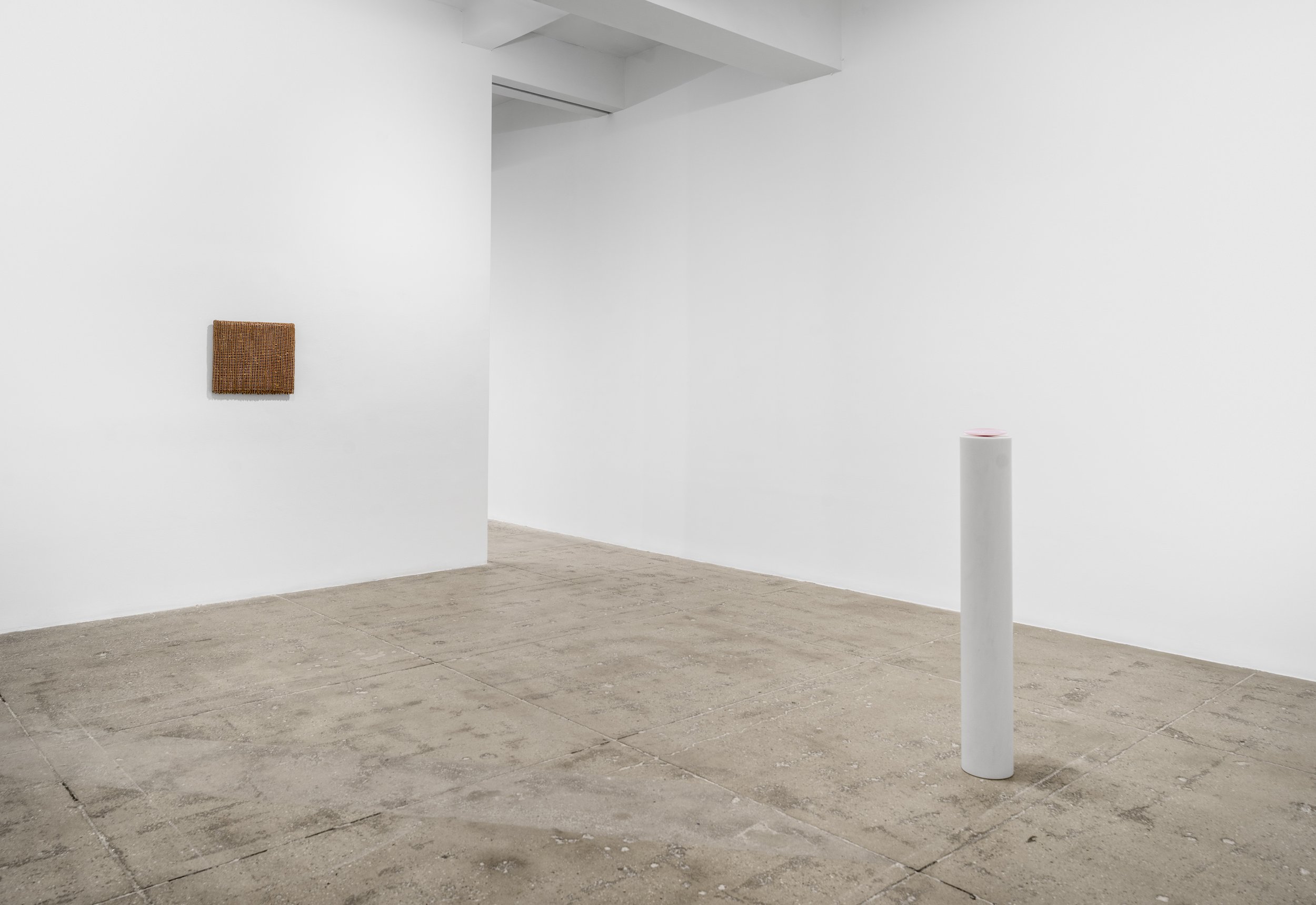
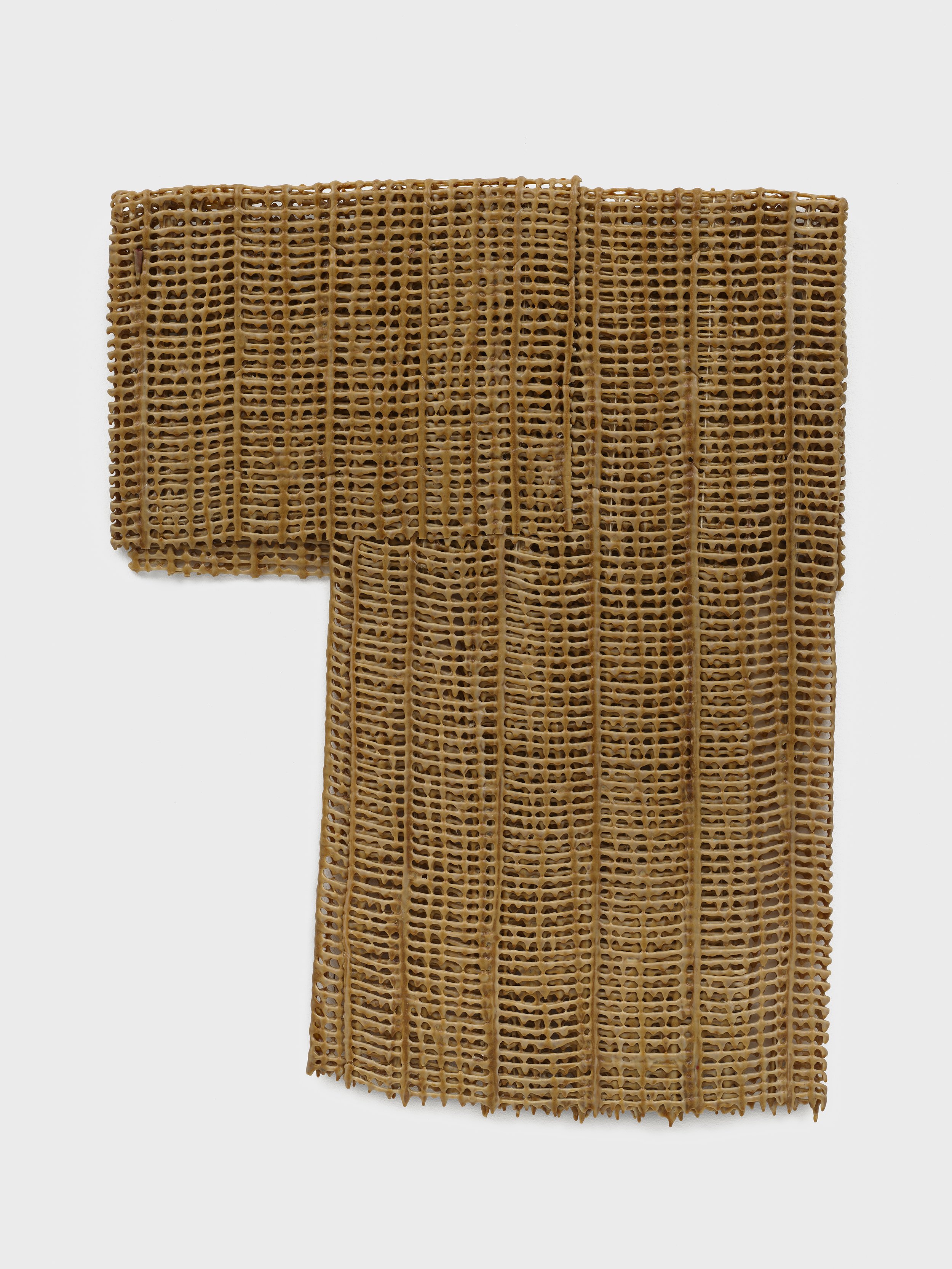

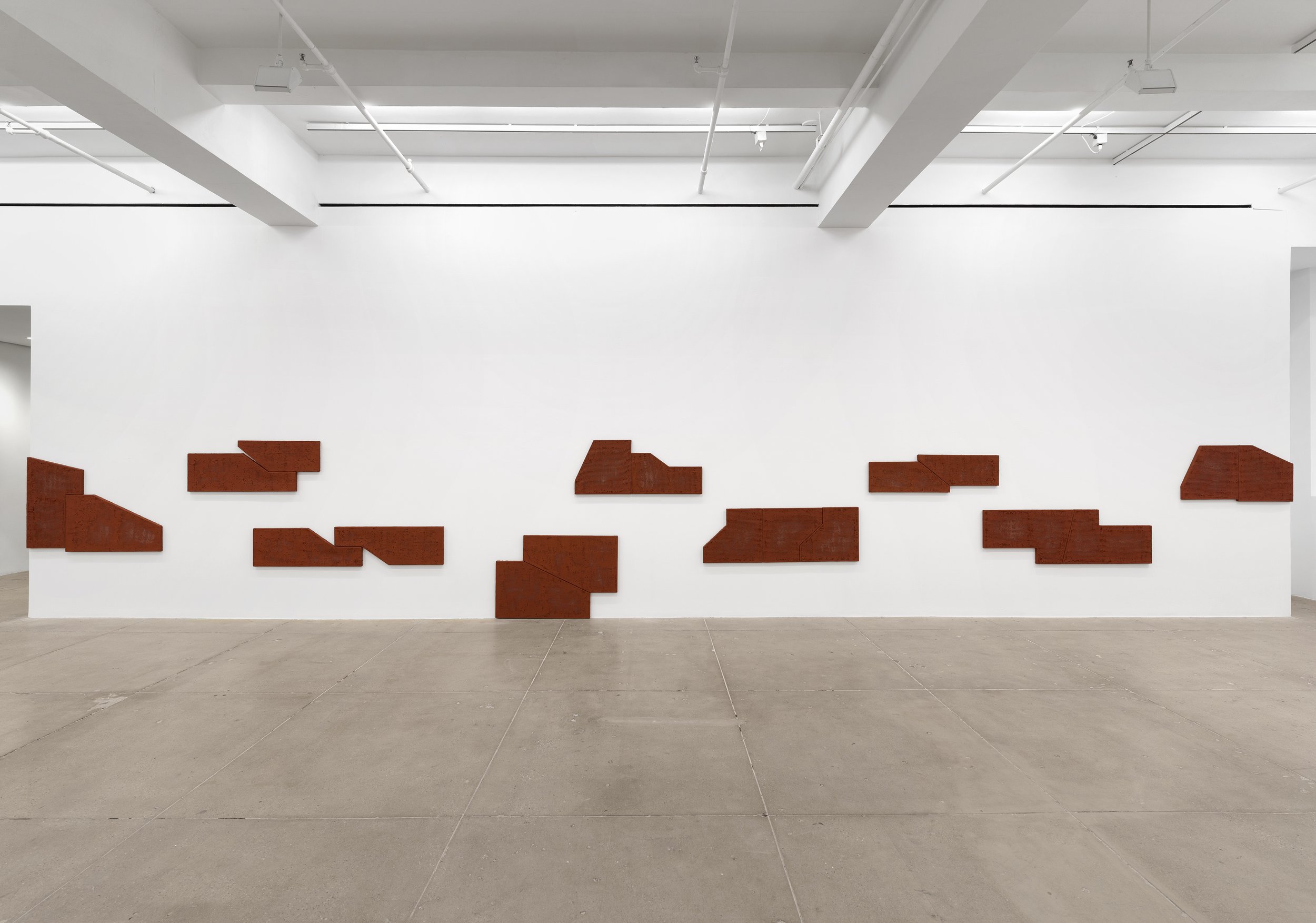
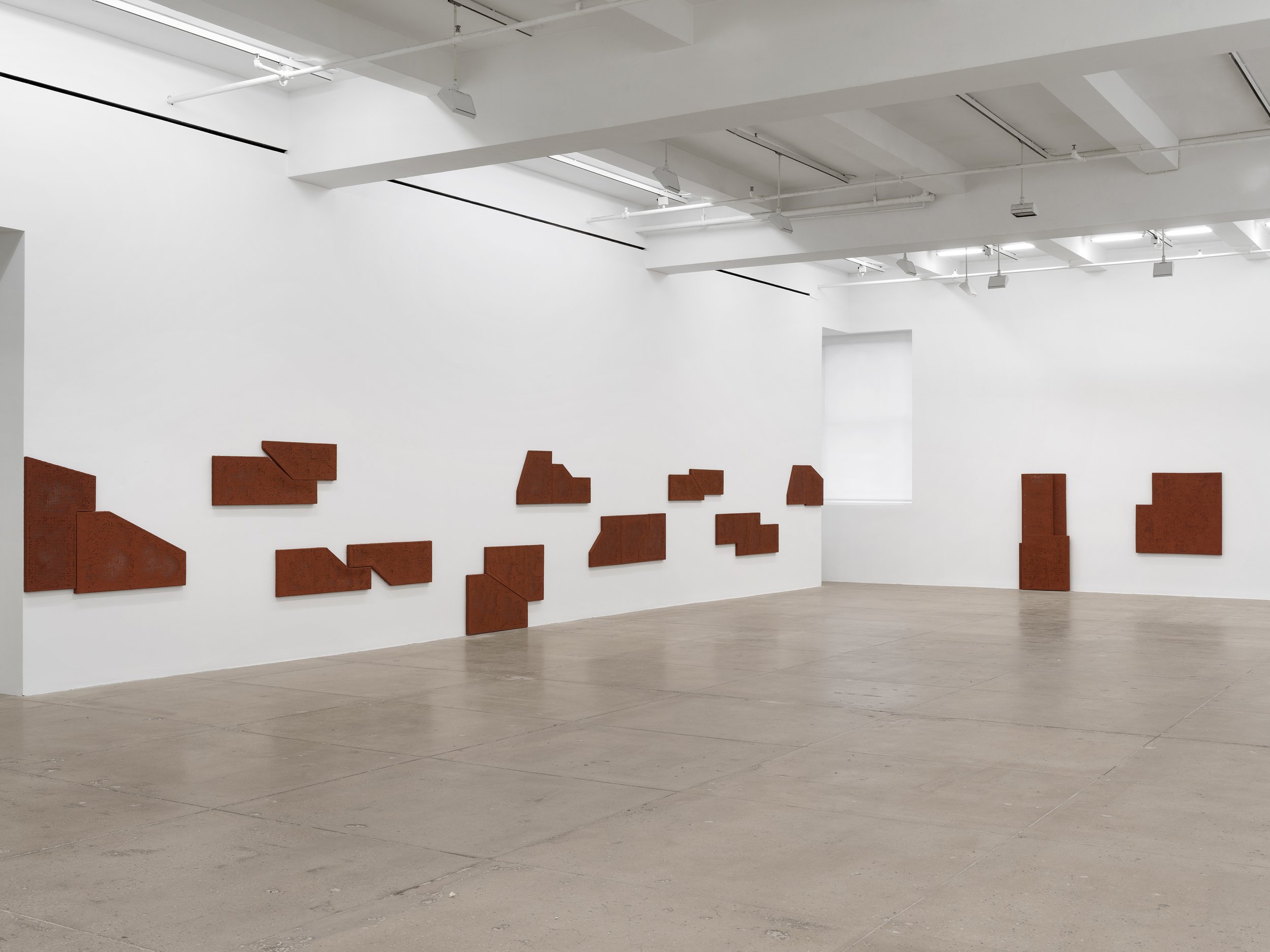
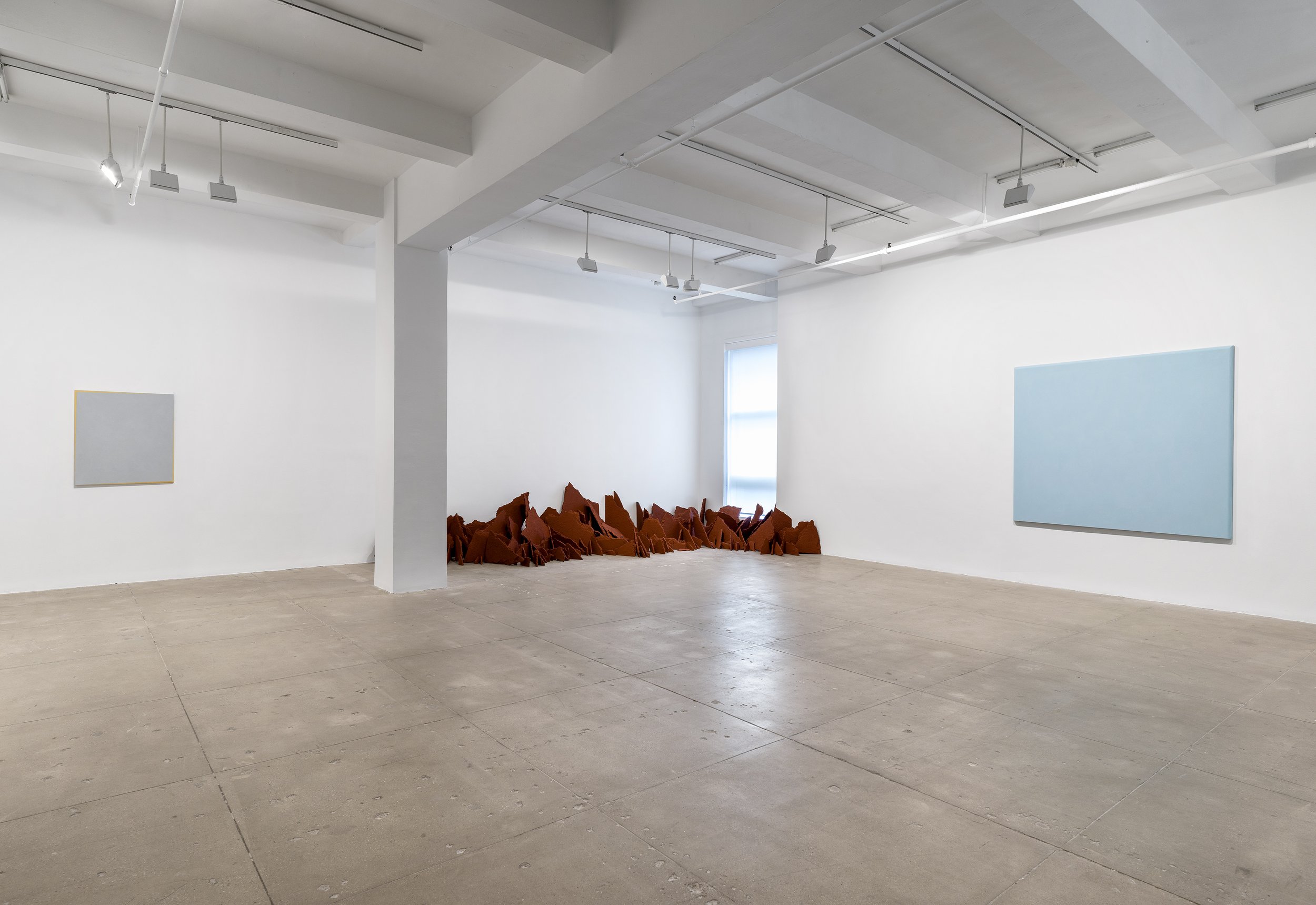
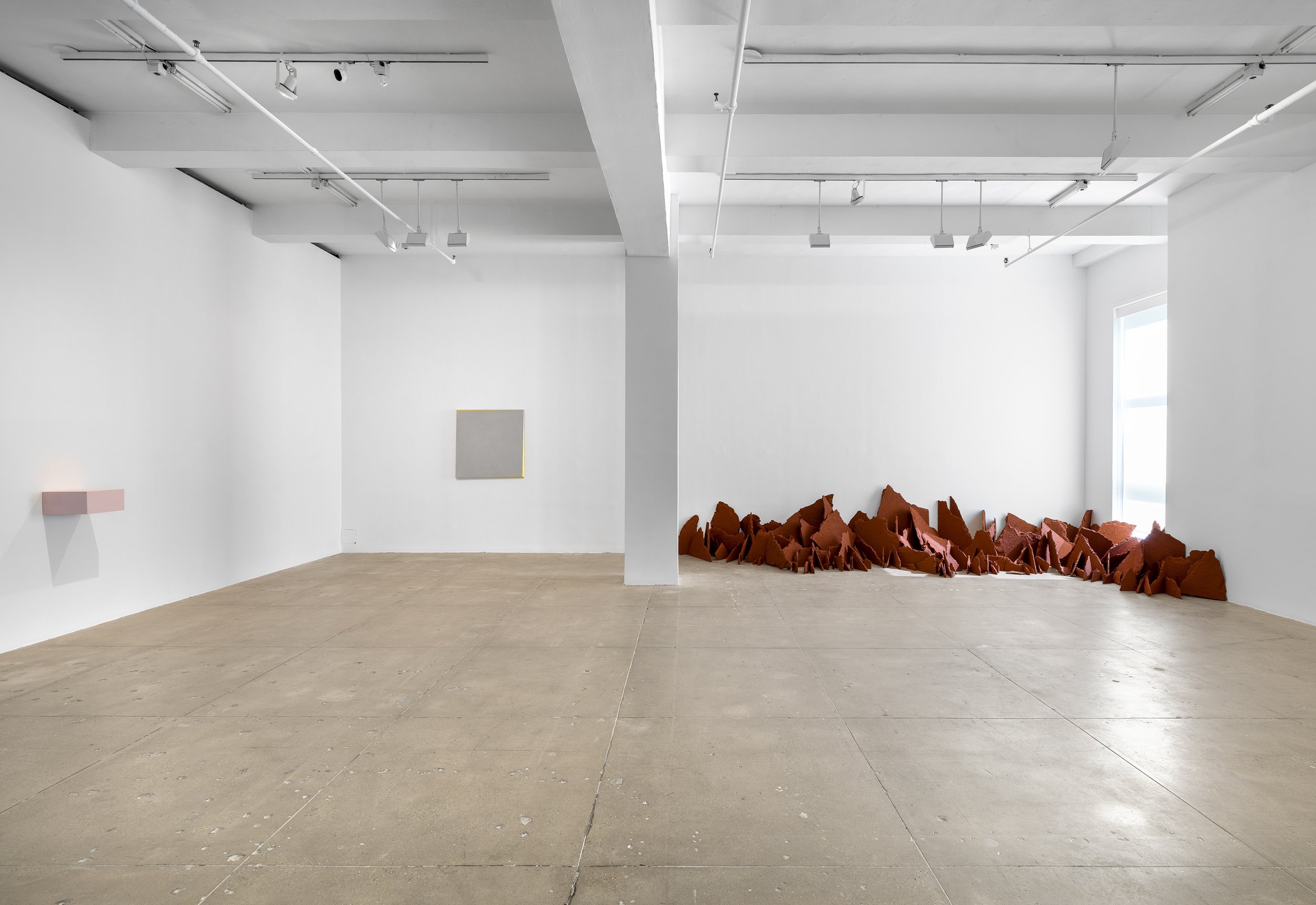
Installation view: Delcy Morelos, Ettore Spalletti, “Esa Esquina Soy Yo”, Marian Goodman Gallery, New York, 2023 Courtesy of Fondazione Ettore Spalletti and Marian Goodman Gallery Photo credit: Alex Yudzon
Morelos' Eva, 2013, acrylic on jute, an installation of the same title made with earth and binder on chipboard, marks Morelos' decisive shift from the pictorial plane to structures in space, anticipating her sculptural practice and large-scale experiential and multisensory installations.
At the Pulitzer Arts Foundation in St. Louis, Interwoven, a solo exhibition of Morelos' work, is scheduled to run from 8 March through 4 August 2024. Delcy Morelos: El Abrazo, on view at Dia Chelsea through 20 July 2024, features two immersive earth-based installations, Cielo terrenal (Earthly Heaven) 2023 and El abrazo (The Embrace) 2023. A catalogue will be published in conjunction with the exhibition.
Ettore Spalletti: Parole di colore, an installation that opened in September 2023 and inaugurated the new Robert Olnick Pavilion at Magazzino Italian Art in Cold Spring, NY, is on view through 6 January 2025, and a publication will accompany the exhibition.
Born in 1967 in Tierralta in the region of Córdoba in Colombia, Delcy Morelos studied at the Cartagena School of Fine Arts. She lives and works in Bogotá. Her practice is rooted in ancestral Andean cosmovision and the aesthetics of Minimal Art. Morelos’ abstract works, with their formidable evocations, inspire rumination on the interplay between human beings and earth, the human body and materiality.
Solo exhibitions include Interwoven, Pulitzer Arts Foundation, St. Louis, MO (2024); El Abrazo, Dia Chelsea, New York (2023); El lugar del alma, Museo Moderno, Buenos Aires, Argentina (2022); Enie, Fundación NC-Arte, Bogotá (2018); Inner Earth, Röda Sten Konsthall, Göteborg, Sweden (2018); La Sombra Terrestre (The Shadow of the Earth), Fundación Fuga, Bogotá (2015); Barranquilla Museum of Modern Art (2006); Gt Gallery, Flax Arts Studios Residence Program, Belfast, Northern Ireland (2006); Academia Superior de Artes de Bogota, Santa Fe Gallery, Bogota (2004); and Color que soy, Museo de Arte de la Universidad Nacional de Colombia (2002).
Selected group exhibitions include The Milk of Dreams, Arsenale Pavilion at the 59th Venice Biennale (2022); Still Alive, Aichi Trienniale in Japan (2022); Something (you can't see, on the other side, of a wall from this side) casts a shadow, SOMArts Culural Center, San Francisco (2018); Medellín, une histoire colombienne des années 1950 à aujourd’hui, Musée des Abattoirs, Toulouse, France (2017); Du som jag, Havremagasinet, Boden, Sweden (2016) and Sami Center for Contemporary Art, Karasjok, Norway (2017); 7 Mercosul Biennial, Grito e escuta (Screaming and Listening), Porto Alegre, Brazil (2009); MDE 07, Espacios de hospitalidad (Hospitality Spaces), Medellín (2007); ES2002 Tijuana/II International Biennial, Tijuana Cultural Center CECUT, Mexico (2002), and the VI Havana Biennial, Cuba (1997).
Ettore Spalletti (1940-2019) was born in Cappelle sul Tavo (Pescara), where he spent his entire life. Compared to contemporary contexts, Spalletti developed a singular, solitary voice and a body of work that transcends any movement that circumscribes an artist to regional or ideological boundaries.
Spalletti has been the protagonist of important international exhibitions, the most recent of which at Nouveau Musee National de Monaco, Monaco (2019) and at Palazzo Cini, Venice (2015). In 2014, three public institutions asked Spalletti to create three exhibitions at the same time at MADRE - Museo d'Arte Contemporanea Donnaregina, Naples, at GAM - Galleria Civica d'Arte Moderna e Contemporanea, Turin, and at MAXXI - Museo Nazionale delle Arti del XXI Secolo, Rome. Other solo exhibitions include: GNAM - Galleria Nazionale d'Arte Moderna, Rome (2010); Museum Kurhaus, Kleve (2009); Académie de France, Villa Medici, Rome (2006); Henry Moore Institute, Leeds (2005); Castello di Rivoli - Museo d'Arte Contemporanea, Rivoli, Turin (2004); Fundación la Caixa, Madrid (2000); Museo di Capodimonte, Naples (1999); Musée d'Art Moderne et Contemporain, Strasbourg (1998); MUHKA - Museum van Hedendaagse Kunst, Antwerp (1995); Solomon R. Guggenheim Museum, New York (1993); ARC - Musée d'Art Moderne de la Ville de Paris, Paris (1991); SMAK - Ghent, Ghent (1983); Museum Folkwang, Essen (1982).
In 2021, after the artist's passing, the Galleria Nazionale d’Arte Moderna e Contemporanea in Rome dedicated a retrospective exhibition to him. Spalletti has participated in the Venice Biennale (1982, 1993, 1995 and 1997) and documenta VII (1982), documenta IX (1992). His major commissioned works include the Chapel of Villa Serena, Pescara, Italy (2016), in collaboration with architect Patrizia Leonelli, and La salle des départs at the Hôpital Raymond-Poincaré, Garches, France (1996), a project for which he was awarded the order of Chevalier des Arts et Lettres de la République Française.
Works by Spalletti can be found, among others, in the permanent collections of the Solomon R. Guggenheim Museum, New York; MUMOK, Vienna; Castello di Rivoli, Turin; MAXXI, Rome-L'Aquila; Galleria Nazionale d'Arte Moderna e Contemporanea, Rome; Villa Litta Menafoglio Panza di Biumo, Varese; Centre Pompidou, Paris; Fondation Louis Vuitton, Paris; Museum Kurhaus, Kleve; SMAK, Ghent; MUHKA, Antwerp; Nouveau Musee National de Monaco, Monaco.
For more information about the exhibit, please visit the Marian Goodman Gallery’s site. The gallery can be found on Instagram and Artsy, too.




